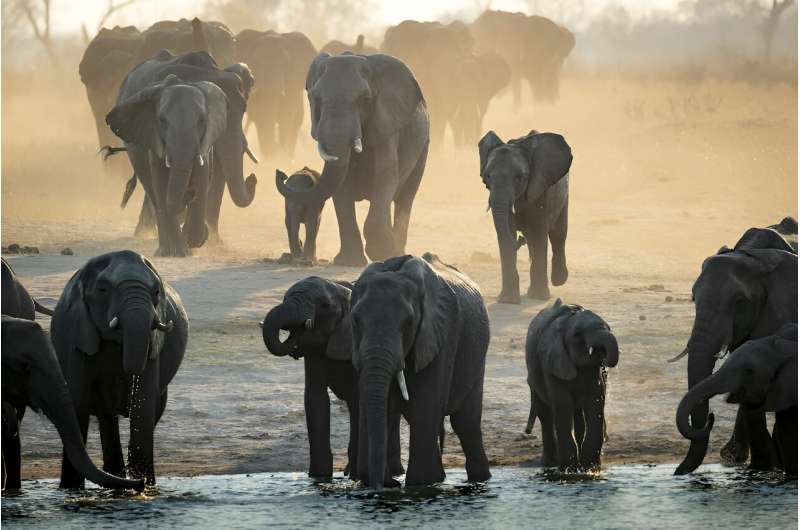This article has been reviewed according to Science X's editorial process and policies. Editors have highlighted the following attributes while ensuring the content's credibility:
fact-checked
peer-reviewed publication
trusted source
written by researcher(s)
proofread
Small 'fortress' parks aren't the answer for Africa's savannah elephants. They need room to roam

Africa is home to about 410,000 savannah elephants (Loxodonta africana), most of them living in southern Africa. Over 290,000 elephants (70%) are spread across 103 protected areas which vary in size, connectivity and protection.
In a recent research paper we explored how elephant populations across southern Africa performed under different conservation approaches. This work formed part of the Conservation Ecology Research Unit at the University of Pretoria, where we focus on science-based, cost-effective approaches to elephant management.
Our study was the most comprehensive analysis of growth for any large mammal population globally and covered an area of 320,000km².
Overall, the results were positive. From 1995 to 2020, elephant numbers across southern Africa grew at an average annual rate of 0.16%. This means that there are the same number of elephants today as there were 25 years ago. This is promising given that globally, savannah elephants are still listed as endangered, meaning that their numbers declined by over 50% within three generations.
Our analysis led us to conclude that the best way to keep overall numbers stable was to allow elephants to roam freely. Keeping elephants in small "fortress" conservation parks may lead to spikes in elephant numbers, but this does not mean the numbers will be stable (more or less the same over time).
Isolating elephants or allowing them to roam?
There are usually two approaches to creating protected areas. Conservation "fortresses" are isolated habitat patches that keep animals in and people out. An example is the 1,640km² Addo Elephant National Park in South Africa.
Our research found that elephants in these small conservation fortresses seemed to flourish but could grow so much that translocation (moving elephants out of a park) or birth control is eventually needed to reduce numbers and to slow growth. Without anywhere for elephants to go, isolated parks could become overcrowded, which might cause damage to the environment and affect animal well-being. This isn't sustainable.
A different approach is to establish clusters of protected areas where well-protected core areas are connected to less-protected buffer areas (such as subsistence farming areas, forestries and communal lands).
This connected approach allows people and wildlife to share resources in the buffer areas, while creating a safe space for animals in the core areas. Connectivity between core and buffer areas allows animals to move into the protected areas when their surroundings become less favorable.
This means that, over time, there's a much higher chance for elephant populations to remain stable.
Our findings showed that elephants in large, well-protected core areas were more stable—neither increasing nor decreasing significantly. These populations enjoy strict protection and minimal human impact, while their connectivity to buffer areas allows for natural movement. Links between clusters of protected areas allow elephants to move into buffers when the core populations gets too high and to return when their environments become unsuitable, or when they face other threats, such as poaching.
What conservation approaches are working?
The global biodiversity goal is to have 30% of the world's landmass protected by 2030. Yet, only 16% of the world's land has been set aside for conservation. Southern Africa is doing better with 20% of land designated as protected. Maintaining these protected areas is very important for conserving elephants and other wildlife species.
However, more attention should be given to how this is done. Maintaining and expanding clusters of protected areas is the best solution for conserving Africa's savannah elephants and their landscapes. While core areas provide safety to elephants and allow populations to remain stable, buffer areas serve as overflow spaces that elephants can move to when cores become overcrowded.
Conservation fortresses often exclude local people and may spark resentment. But buffer areas that surround core protected areas can be established in cooperation with local communities, who can then also benefit economically.
Buffer areas must be created responsibly to ensure that people's safety and livelihoods are not negatively affected.
Connecting protected areas is not only important for the survival of African savannah elephants, but also for other animal and plant species. Populations with more options for moving around are healthier and more stable, which is important given an uncertain future from climate change.
More information: Ryan M. Huang et al, Protecting and connecting landscapes stabilizes populations of the Endangered savannah elephant, Science Advances (2024). DOI: 10.1126/sciadv.adk2896
Journal information: Science Advances
Provided by The Conversation
This article is republished from The Conversation under a Creative Commons license. Read the original article.![]()




















